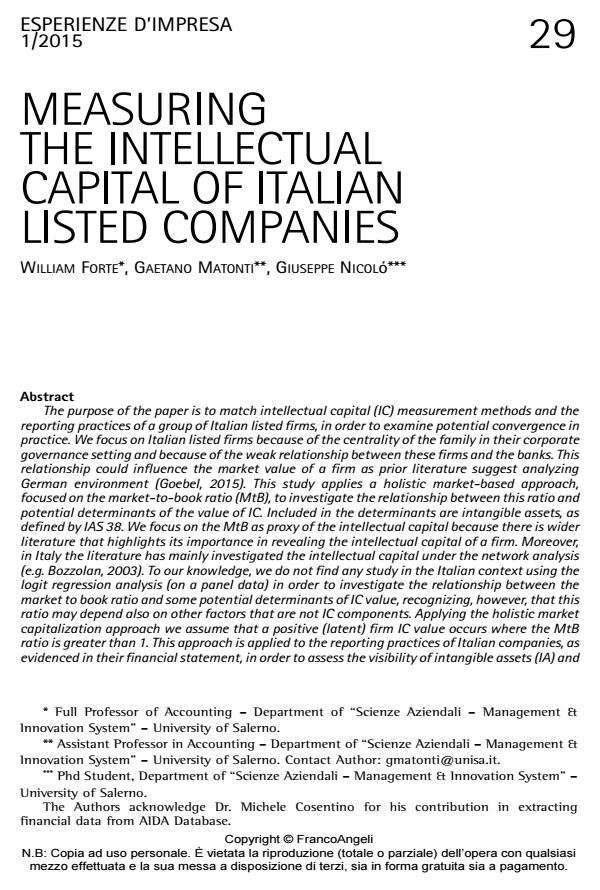Measuring the intellectual capital of italian listed companies
Titolo Rivista ESPERIENZE D'IMPRESA
Autori/Curatori William Forte, Gaetano Matonti, Giuseppe Nicolò
Anno di pubblicazione 2016 Fascicolo 2015/1
Lingua Italiano Numero pagine 33 P. 29-61 Dimensione file 297 KB
DOI 10.3280/EI2015-001002
Il DOI è il codice a barre della proprietà intellettuale: per saperne di più
clicca qui
Qui sotto puoi vedere in anteprima la prima pagina di questo articolo.
Se questo articolo ti interessa, lo puoi acquistare (e scaricare in formato pdf) seguendo le facili indicazioni per acquistare il download credit. Acquista Download Credits per scaricare questo Articolo in formato PDF

FrancoAngeli è membro della Publishers International Linking Association, Inc (PILA)associazione indipendente e non profit per facilitare (attraverso i servizi tecnologici implementati da CrossRef.org) l’accesso degli studiosi ai contenuti digitali nelle pubblicazioni professionali e scientifiche
The purpose of the paper is to match intellectual capital (IC) measurement methods and the reporting practices of a group of Italian listed firms, in order to examine potential convergence in practice. We focus on Italian listed firms because of the centrality of the family in their corporate governance setting and because of the weak relationship between these firms and the banks. This relationship could influence the market value of a firm as prior literature suggest analyzing German environment (Goebel, 2015). This study applies a holistic market-based approach, focused on the market-to-book ratio (MtB), to investigate the relationship between this ratio and potential determinants of the value of IC. Included in the determinants are intangible assets, as defined by IAS 38. We focus on the MtB as proxy of the intellectual capital because there is wider literature that highlights its importance in revealing the intellectual capital of a firm. Moreover, in Italy the literature has mainly investigated the intellectual capital under the network analysis (e.g. Bozzolan, 2003). To our knowledge, we do not find any study in the Italian context using the logit regression analysis (on a panel data) in order to investigate the relationship between the market to book ratio and some potential determinants of IC value, recognizing, however, that this ratio may depend also on other factors that are not IC components. Applying the holistic market capitalization approach we assume that a positive (latent) firm IC value occurs where the MtB ratio is greater than 1. This approach is applied to the reporting practices of Italian companies, as evidenced in their financial statement, in order to assess the visibility of intangible assets (IA) and the extent to which they explain the value of IC (Lev and Zambon, 2003). According to conservative and prudential accounting conventions, several factors may give rise to a mismatch between IC and IA, including: only partial alignment of accounting categories with IC terminology; the limited recognition of R&D expenses and internally generated intangibles as accounting assets; the retrospective character of valuation; and the virtual absence of "human capital" in conventional statements. However, even if such factors were to be removed from the firm-level valuation of IA, and the value of each asset could be explained using its market-value, the sum of these values will not capture the "holistic effect" of interactions between IC components which typically generate an overall value which is greater than the aggregate value of single estimates. Therefore, this study examines the relationship between MtB ratios, where they are greater than unity, and selected determinants drawn from the existing literature, including intangible assets, firm profitability, firm age, firm size, and so on, consistent with Morariu (2014), Goebel (2015), and Cheng and Liu (2015). Our empirical study is conducted for a panel of 148 Italian companies listed on the Milan Stock Exchange at the end of 2013, and draws upon annual reports for the financial years 2009-2013. We estimate a logistic regression model, in which the dichotomous dependent variable is given the value 1 if the firm MtB ratio exceeds 1, against independent variables including total and individual intangible assets, ROA, size, age, leverage, concentrated and family ownership, auditing, and industry type. Our results indicate a positive and moderately significant association between positive MtB and total intangible assets, a finding that is not consistent with Goebel (2015) who finds no association between LRVTB value (an MtB variant) and intangible assets. We argue that this result may be attributed both to the limitations of conventional accounting measures but also to investors’ perception of a value of firms greater than the sum of the value of each intangible asset recognized in the financial statements (that is the "holistic effect" of interactions among individual intangible assets). Further, we find a significant positive relationship between positive MtB and firm profitability (ROA). Finally, we find that IC value is significantly higher for firms which engage a Big 4 auditor. Thus, we argue that the balance sheet book value for such firms reflects greater conservatism in recognition criteria according to IAS 38, and less earnings management, than in firms audited by a non-Big 4 auditor. Moreover, the resulting significant negative relationships between the MtB ratio and firm age and size suggest that younger and smaller firms are able to implement more effective strategies of investment in intangible assets in order to create firm value (that is, IC value). Other factors that we find not to be significantly associated with IC value include leverage, recognized R&D expenses, patents and trademarks, goodwill, concentrated and family ownership, and industry membership. Our paper contributes to the literature on IC measurement in analyzing the appropriateness of MtB in order to detect the IC value. We focus on Italian context that differs from German environment for the character of corporate governance of Italian listed firms and for the predictive variables that include all components of intangible assets (e.g. goodwill, patents, trademarks, etc).
Parole chiave:Intellectual capital, measurement, total intangible assets, listed firms, market to book ratio
William Forte, Gaetano Matonti, Giuseppe Nicolò, Measuring the intellectual capital of italian listed companies in "ESPERIENZE D'IMPRESA" 1/2015, pp 29-61, DOI: 10.3280/EI2015-001002